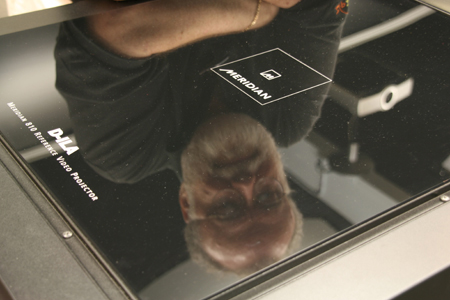Realer Than Real


Based on a similar JVC projector designed for professional flight simulators, the 810 is intended for the ultra-high-end home-theater market. How ultra-high-end? A mere $185,000 gets you the projector, an outboard video processor, an ISCO3 anamorphic lens with motorized sled, and two complete calibrations—one for a white screen such as the Stewart Studiotek 130 and another for a gray screen such as the Stewart GrayHawk.

The calibration process, which was designed by video guru William Phelps, takes four days to complete for each type of screen material. In addition to grayscale, color accuracy, and other typical parameters, the process also addresses white-field and color uniformity, with less than 0.3% deviation in both across the entire screen. The calibration puts 16 foot-lamberts (the SMPTE-standard peak light level for commercial cinemas) on a 2.35:1 screen up to 24 feet wide.

Unlike its JVC counterpart, the 810 does not mask the imaging chips, which have a native aspect ratio of 17:10. To fill a 16:9 and 2.35:1 screen, the system must do some overscanning, which uses more pixels than masking would allow.

The outboard processor is based on a chipset from Marvell and connects to the projector with four DVI cables that drive different quadrants of the D-ILA panels. It can accept any signal from 480i to 1080p and upscale it to 10 megapixels. Interestingly, the processor has only two inputs—one HDMI and one DVI—so most systems will need an upstream switcher. However, it also has 12 memories called "phantom inputs" that can be tweaked for different sources.
If you haven't heard of Marvell, it makes chipsets for various applications—for example, the WiFi chipset in the PS3 and iPhone. The company is now entering the A/V market with a suite of technologies under the Qdeo ("Quiet Video") marketing moniker.

All of this sounds great, but how does it look? I've seen several demos of the 810, and all I can say is, Wow! Well, okay, I can say more than that. The material I've seen has not included any native 4K content, but there has been lots of 1080p upconverted to 10MP. The server had off-air HDTV broadcasts from NBC and PBS, clips ripped from Blu-ray and HD DVD titles, and QuickTime HD material such as one might download.
Even though the content was upconverted 1080p, it looked far better than any 1080p I've ever seen. The white-field and color uniformity really paid off in the depth of the image, which looked positively three-dimensional. Blacks were stunning, colors were gorgeous, and detail was breathtaking.
Of course, there is no native 4K commercial content available—yet. But if Fox has its way, there could be in the future. Still, what this system does with 1080p is almost magical, so those with $185,000 burning a hole in their pocket can easily surpass anything their neighbors might have.
- Log in or register to post comments




































































